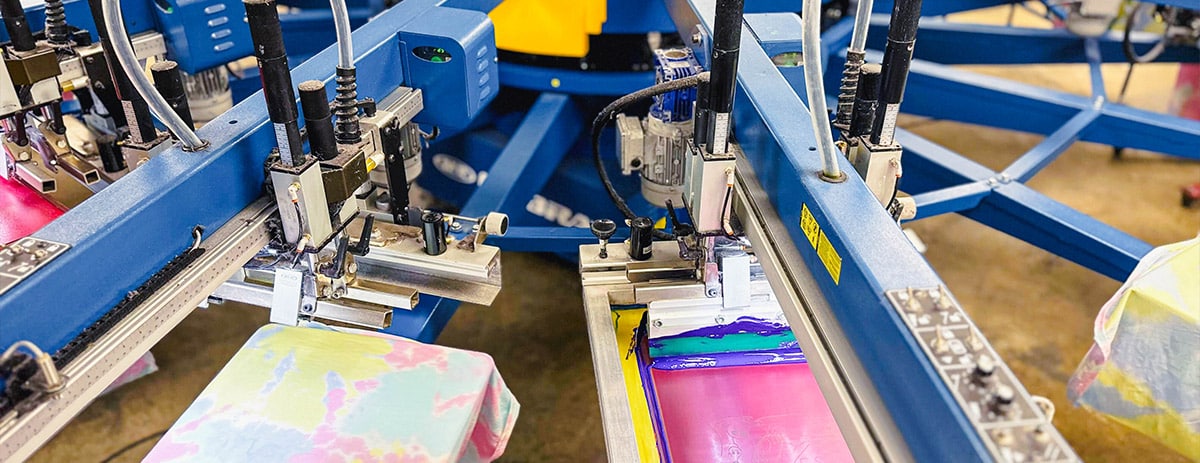Artistic Silk Screen Printing for Limited Edition Prints
Wiki Article
Screen Printing Uncovered: Every Little Thing You Required to Understand About Tee Shirt and Garment Printing Methods
If you have actually ever questioned just how those vibrant styles wind up on your favored tee shirts, you're in the ideal location. Screen printing is a remarkable technique that incorporates art with strategy, offering limitless opportunities for imagination. Comprehending the fundamentals, from tools to ink selections, can substantially affect your outcomes. All set to explore the crucial elements that make screen printing an art type? Let's reveal the information that can elevate your tasks.
The Basics of Screen Printing: Exactly How It Functions
When you plunge into screen printing, you'll discover it's both an art and a scientific research. At its core, screen printing involves creating a pattern, or screen, that permits ink to pass through only in particular areas.Setting the display over the material, after that use a squeegee to press ink with the display onto the garment. Each step is essential, and understanding them will certainly raise your display printing skills, changing easy garments right into special, expressive pieces.
Sorts Of Display Printing Strategies
As soon as you realize the fundamentals of screen printing, it's time to discover the different strategies that can elevate your designs. One preferred method is conventional screen printing, where ink is pressed through a stenciled screen. This technique is terrific for bold, vivid colors. There's water-based ink printing, which supplies a softer feeling and is environmentally friendly, but it needs a various method to curing.If you're aiming for fine details, take into consideration discharge printing. This method gets rid of color from the textile, leaving a soft, vintage appearance. Another option is plastisol printing, known for its toughness and dazzling colors, making it a favored for numerous brand names. Finally, experiment with halftone printing to create slope impacts and elaborate layouts. Each method has its distinct beauty, so don't wait to try them out to find what fits your design best!
Crucial Tools for Display Printing
To achieve spectacular lead to screen printing, having the right devices is essential. First, you'll need a tough display printing framework, which holds the mesh that transfers your style onto the garment. Next off, buy premium mops; these are crucial for applying ink equally throughout the screen. You'll likewise need an excellent exposure unit to create your screens, as well as a washout cubicle for cleaning them after usage. A dependable warm resource, like a conveyor dryer or heat press, is vital for treating your prints to assure long life. Don't fail to remember a correct office, outfitted with tables and storage for your products. Protective gear, such as handwear covers and masks, will certainly maintain you risk-free from chemicals and inks. With the right tools, you'll be well on your means to generating professional-quality prints.Picking the Right Inks and Materials
When picking inks and products for display printing, you require to take right into account the kind of ink that functions finest for your project. Believe about material compatibility to guarantee your styles look fantastic and last long. Also, check out environmentally friendly ink options to make your printing procedure much more sustainable.Kinds Of Display Inks
Choosing the best display ink is necessary for achieving dynamic, durable prints that satisfy your project's needs. There are numerous types of screen inks to examine. Specialized inks, such as metal or glow-in-the-dark, can include special effects to your layouts.
Material Compatibility Factors To Consider
Understanding fabric compatibility is essential for accomplishing premium screen prints, particularly considering that various materials respond distinctly to numerous inks. When picking inks, consider the material type-- cotton, polyester, or blends. For cotton, water-based inks work well, using softness and breathability. Polyester, on the various other hand, usually needs plastisol inks for much better bond and dynamic colors. If you're publishing on blends, you might require to utilize a combination of both kinds. Constantly evaluate your inks on example material to guarantee they stick appropriately and keep color honesty. Additionally, remember that material weight and structure can influence the final outcome, so selecting the best ink and material combo is crucial for your project's success.Eco-Friendly Ink Options
Eco-friendly inks are coming to be a popular selection for display printers that want to decrease their environmental influence while preserving quality. When selecting inks, consider water-based inks, which are less dangerous and easier to clean up compared to typical solvents.In addition, seek inks made from eco-friendly sources, such as soy or vegetable-based choices. By selecting the appropriate inks and materials, you'll not only develop magnificent layouts yet also contribute to an extra sustainable printing procedure. Make the button, and your prints will certainly reflect your dedication to the environment!
Preparing Your Layout for Display Printing

Submit Layout Demands
To assure your style looks sharp and lively on textile, you'll need to pay very close attention to submit layout needs for screen printing. Start with vector files like AI or EPS, as they can be scaled without shedding top quality. If you utilize raster photos, select high-resolution files, such as TIFF or PNG, preferably at 300 DPI. Avoid using JPEGs, custom screen printing as they can lose quality when resized. Also, ensure your layout has a transparent history to avoid undesirable white sides on your prints. Ultimately, maintain color settings in mind; CMYK is typical for display printing, so transform your RGB designs appropriately. By following these standards, you'll establish your art work up for an effective print.Color Separation Techniques
Shade separation is an essential action in preparing your design for screen printing, and understanding it can significantly boost your print high quality. You'll require to damage your design right into individual shades, as each shade requires a different display throughout printing. Start by recognizing all the colors in your style and produce layers for each one. You can use software like Adobe Photoshop or Illustrator to isolate and different shades efficiently. Be specific to conserve each layer as a different documents, usually in a style like TIFF or PSD. This precision not only assures exact color representation but likewise simplifies the printing procedure. By paying interest to color separation, you'll achieve specialist and vivid results in your screen-printed garments.Resolution and Dimension
Achieving the most effective lead to screen printing starts with guaranteeing your design has the best resolution and dimension. Ideally, your art work ought to go to the very least 300 DPI (dots per inch) for sharp, clear prints. Your last product could look pixelated and amateur. if you make use of lower resolution.When it involves size, take into consideration the measurements of your print area. Design your artwork to match the final print size, preferably developing it in the actual measurements you'll be printing. In this manner, you'll avoid any type of unforeseen scaling issues.
Constantly inspect your style in both vector and raster formats. Vector graphics can be scaled without shedding high quality, making them ideal for display printing. Preparing properly will assure your style looks fantastic on every garment!
Step-by-Step Screen Printing Refine
Display printing is a vibrant procedure that permits you to create vibrant styles on different surface areas. To get going, you'll require a display, emulsion, and your selected ink. Prepare your display by cleaning it extensively. Next, use the solution evenly and allow it completely dry in a dark location. Once completely dry, expose your screen to light with your layout put on it, which will certainly set the emulsion where the light hits, creating a stencil - screen printing kit.After washing out the unexposed emulsion, your screen is ready. Establish it up on your printing surface area and straighten your garment beneath it. Pour ink onto the display and make use of a squeegee to push the ink with the pattern onto the textile. Lift the display thoroughly and allow the print dry. Finally, heal the ink using warmth to guarantee durability. That's it! You have actually effectively display printed your layout.
Tips for Successful Display Printing Projects
While you're diving right into your display printing tasks, bear in mind that preparation is essential to success. Beginning by collecting all your products-- inks, screens, mops, and garments. A clean work space helps prevent unwanted mistakes, so tidy up prior to you start.Following, confirm your art work is high-resolution and properly sized for your garment. Examine your display for proper direct exposure and tidy it thoroughly to prevent smudges. When mixing your inks, comply with the manufacturer's guidelines to attain the best uniformity.
During printing, use also pressure with your squeegee for constant outcomes. Don't hurry; take your time to confirm each print satisfies your standards. After printing, allow your garments completely dry totally prior to managing or packaging them.
Lastly, always keep a sample of your benefit future recommendation. By doing this, you can assess your progress and enhance your techniques gradually. Delighted printing!

Regularly Asked Inquiries
How much time Does It Take to Set up a Display Printing Work?
Establishing a display printing work normally takes about thirty minutes to an hour. You'll prepare the displays, mix inks, and adjust the press. The time varies based on intricacy and experience, so remain arranged!Can I Print on Various Textile Types Utilizing the Very Same Method?
Yes, you can publish on different fabric types using the same technique, yet you'll need to readjust your settings and inks. Some textiles soak up ink in a different way, so exploring assurances the most effective outcomes for each and every material.What Are Common Mistakes to Stay Clear Of in Display Printing?
When display printing, prevent common blunders like making use of the wrong ink, neglecting appropriate direct exposure times, or skipping pre-press checks. Always test your arrangement and maintain clean screens to assure high quality outcomes each time.Just How Can I Correctly Clean and Preserve My Screen Printing Devices?
To properly tidy and preserve your display printing devices, you should routinely wash screens with suitable solvents, examine squeegees for wear, and ensure all devices are saved completely dry and dust-free. Uniformity boosts and protects against expensive repair services performance.Is Screen Printing Eco-friendly Compared to Other Techniques?
Screen printing can be extra environmentally friendly than other approaches, specifically if you utilize water-based inks and eco-conscious materials. By choosing sustainable products and practices, you lower waste and reduce your impact on the planet.Display Printing Uncovered: Whatever You Need to Know Concerning Tee and Garment Printing Methods
At its core, screen printing involves developing a pattern, or screen, that enables ink to pass with just in specific locations. Setting the display over the fabric, then utilize a squeegee to push ink through the screen onto the garment. One preferred technique is conventional display printing, where ink is pushed with a stenciled display.When picking inks and products for screen printing, you need to take right into account the kind of ink that functions ideal for your job.
Report this wiki page